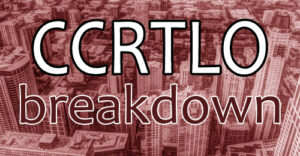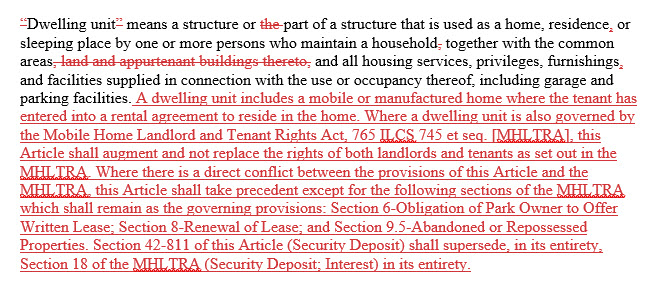 Section 803 – Definitions
Section 803 – Definitions
In this installment of breaking down the Cook County Residential Tenant and Landlord Ordinance (CCRTLO), we will look at Section 42-803 which defines certain terms under the ordinance. Okay, I know this one is going to be boring (hence, I’m releasing it on a Friday night and you now have your weekend homework), but there is a silver lining. Some of these definitions (and the comparison and contrast to definitions in the Chicago Residential Landlord and Tenant Ordinance (CRLTO)) will foreshadow future differences we will highlight in the CCRTLO as we delve deeper into its requirements in future blog posts. Let’s begin.
A1. Dwelling Unit
The CCRTLO, like the CRLTO, first defines a “Dwelling Unit”:

Initially, the definition is nearly the same as the definition from the Chicago Ordinance with the exception being the omission of the words “land and appurtenant buildings thereto”. The ordinance goes on to make clear that the definition of dwelling unit includes mobile homes where the tenant is renting the mobile home and then does some housekeeping regarding the applicability of the Mobile Home Landlord and Tenant Rights Act and its interrelation with the CCRTLO. Landlords should clearly understand that a dwelling unit includes more than the unit itself but also extends to common areas, services, facilites, etc. which could have an impact on a landlord’s decisions.
A2. Harass or harassing
This one is new. I was going to post a verbatim definition, but I need to post the exact wording from the ordinance for reasons that will become clear.
“Harass or harassing means knowing conduct which is not necessary to accomplish a purpose reasonable under the circumstances that would cause a reasonable person emotional distress to the tenant and does cause emotional distress to another.”
Now, I wasn’t an English major, but my high school AP English teacher at St. Viator, good old Brother Ruhl, taught me a little bit about the English language. Honestly, I’m not sure what that sentence means. Obviously, we can expect that somewhere later in the ordinance, tenants will be entitled to claim their landlord was harassing them. But what is the standard? It’s good that they tempered it with requiring that the conduct be “knowing conduct” meaning there needs to be some intent on the part of the harasser. However, the conduct has to “cause a reasonable person distress to the tenant”? It seems that the author of this sentence was too eager to give a definition that might result in harassing conduct by a landlord OR a tenant and basically wanted to make harassment only something a landlord could engage in. Then, the sentence fragment “and does cause emotional distress to another”… what does that even mean? I feel like an “or” is missing somewhere in there and maybe a few commas.
A3. Landlord
A Landlord is the owner, agent, lessor, sublessor, or the successor in interest of any of them of a dwelling unit or the building of which it is part. This definition is word-for-word straight out of the Chicago ordinance. Two items of interest. First, an agent (like perhaps a real estate agent?) is directly mentioned. So, whatever a real estate agent does will likely be attributed to the landlord. Agents working on behalf of landlords better know their stuff when it comes to Cook County leasing. Second, sublessors can also be landlords. So, the poor tenant who finds a subtenant is also going to be subject to the strictures of this ordinance. Talk about turning the tables!
It is worth noting that the term “Successor landlord” is defined in the CRLTO 5-12-030(i) but there is no such definition contained in this section.
A4. Move-in fee
Uh oh. If you have read any of the commentary on the CCRTLO, you’ve heard landlord activists claim that the ordinance does away with move-in fees. You will also hear tenants’ rights activists and Cook County commissioners claim “no we haven’t”. Well, let’s see here. A move-in fee is a “fee that a landlord charges to a tenant that is reasonably related to the landlord’s cost for a tenant moving into the dwelling unit including, but not limited to, additional security costs or additional trash removal. I’d hazard a guess that those words “reasonably related” are going to give tenants’ attorneys a lot of room to bring claims that a landlord’s fees are not “reasonably related”. I’m not going to get too deep into this here because we will get into the specifics in later sections of the ordinance, but let’s just say that this definition and related-provisions will be the end of the move-in fee as we know it.
A5. Owner
Next we have the definition of Owner which is also cribbed directly from the CCRLTO. An Owner is one or more persons who have all or part of the legal title to the property or all or part of the beneficial ownership, and a right to present use and enjoyment of the premises including a mortgagee in possession. So people named on title or beneficiaries of land trusts are owners.
A6. Owner-occupied
We have no definition of owner-occupied in the CRLTO. The Cook County ordinance is going to give us one. That’s good because the concept of an owner-occupied property is usually related to an exemption from the ordinance as we saw in our review of Section 802. “Owner-occupied means that the residential building, or at least a portion or one unit thereof, condominium, or cooperative, is occupied by the owner of the residential building as their principal residence.” So, property is owner-occupied if an owner (as defined in 803(A)(5)) “occupies” the residential property as their principal residence. This is in line with some of the caselaw for CRLTO cases. An owner has to actually use the property as their principal residence (ie. a cot in the basement where they stay when they work on the building won’t cut it).
A7. Person
The CCRTLO defines a person as an individual, corporation, government, governmental subdivision or agency, business trust, estate, trust, partnership or association, or any other legal or commercial entity, unless otherwise expressly excluded. This is a replica of the CRLTO except for the part about “unless otherwise expressly excluded”. I wonder who/what the County intends to exclude.
A8. Premises
Premises means the dwelling unit, and the structure of which it is a part, facilities and appurtenances therein, and grounds, areas, and facilities held out for the use of tenants. Same as the CRLTO.
A9. Rent
Rent means all payments to be made to the landlord under the rental agreement. When it is used as a determination of damages, and the tenant has a subsidized rent, such as a Housing Choice Voucher, “rent” shall mean the full market rent, not the tenant rent based on income. This is a bit different than the CRLTO which indicates that “Rent means any consideration, including any payment, bonus, benefits or gratuity, demanded or received by a landlord for or in connection with the use or occupancy of a dwelling unit.” The Cook County definition is broader. If I were thinking “hey, Cook County wants to stick it to the landlords”, I might think that this section proves it. The definition of rent is expanded to “all payments to be made to the landlord under the rental agreement” but the definition goes on to say that in determining damages, it includes any rental subsidy paid. So, when a provision in the CCRTLO says a landlord has to pay the tenant “two times the monthly rent”, they don’t mean the unsubsidized portion of the rent, it means all of the rent, both subsidized and unsubsidized. Glad they got that out of the way. It already seems, just based on what should be an innocuous set of “definitions” that Cook County landlords are in for it.
A10. Rental Agreement
The Rental Agreement or lease is a written or oral agreement, and any valid rules and regulations adopted pursuant to subsection 808(C), embodying the terms and conditions concerning the use and occupancy of a dwelling unit and premises. The Chicago ordinance is similar but does not include “any valid rules and regulations adopted pursuant to Subsection 808(C)”. Hmmm. Does this foreshadow that we are going to have some rules about the rules and regulations? Stay tuned. I bet we will.
A11. Security Deposit
Now we get down to some of the battle-ground terminology. What is a security deposit? For instance, does it include a pet deposit? What about move-in fees that have been defined above? Well, a security deposit is “funds provided to a landlord to secure payment or performance of a tenant’s obligations under a rental agreement, or the obligations of the tenant for its guests or pets, and the identifiable proceeds of the funds, however denominated. The term does not include rent or fees.” So, whatever name you give to your deposit, if it is to secure payment or performance of the tenant’s obligations under the rental agreement itself or to secure the tenant’s obligations for the tenant’s guests or pets, it is a security deposit. The only other things something can be would be “rent” and “fees”. Rent, again, is defined above as “all payments to the landlord under the rental agreement”, so isn’t a security deposit also within the definition for rent? I don’t think so. It looks like there’s a distinction based on “payments to landlord”. Yes, you pay a security deposit to a landlord in the sense that you give it to the landlord, but it is not money that becomes the landlord’s money. How about fees? We don’t have a definition of fees alone, but we do have a definition of move-in fees. That’s a “fee that a landlord charges to a tenant that is reasonably related to the landlord’s cost for a tenant moving into the dwelling unit.” Well, that is a payment to the landlord under the rental agreement, so is that “rent”? Confused? I am. I think this is bad draftsmanship and will need to be corrected or clarified.
A12. Tenant
The definition of tenant is exactly the same as in the CRLTO. Tenant means a person entitled, by written or oral agreement, subtenancy approved by the landlord, or by sufferance, to occupy a dwelling unit to the exclusion of others.
A13. Written Notice
This one is new to the CCRTLO. Written Notice means communications in writing shared as handwritten, typed, or printed documents, mailed documents, or electronically mailed or messaged documents. So, written notice can be given via a variety of communication methods. When I see this list, I am immediately reminded of the requirement that a landlord’s right of access in 5-12-050 of the CRLTO requires notice communicated “by mail, telephone, written notice to the dwelling unit, or by other reasonable means designed in good faith to provide notice to the tenant.” This definition is not quite as broad as the CRLTO definition.
Conclusion
So, there you have it. Section 42-803 is pretty similar to Section 5-12-030 of the CRTLO but has just a bit more of a sinister, anti-landlord undertone. Not unexpected. We’ve defined our terms and now we can get on to the good stuff. The next section we will examine is Section 804 on rental agreements which I promise will be eye-opening to Cook County landlords!
